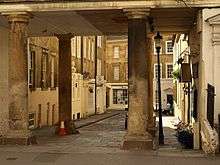Pierrepont Place, Bath
Pierrepont Place is a mews street in Bath, England. Records indicate that Pierrepont Place and properties on it were built by John Wood the Elder between 1732 and 1748, on land once belonging to monks of Bath Abbey, who had used it as an orchard.

Most houses on the street are Grade II listed Georgian townhouses and include 4 Pierrepont Place (Grade II listed and built between 1740 and 1750),[1][2] 5 Pierrepont Place - Grade II listed and built around 1748) and Masonic Hall (previously the Old Orchard Street Theatre). 5 Pierrepont Place was previously owned by the Bath Freemasons for 200 years, after purchasing the house along with the theatre building in 1809 for £25.
History
Bath Abbey, formally known as Priory Church, had an orchard which was given to the City by Edmund Colthurst in 1572. The land was then sold in 1612 to John Hall of Bradford-on-Avon and was passed through the family for a century. It was not until 1711 that the Hall’s estate went to Rachel Bayntun, who became Countess of Kingston. Her husband died in 1713, possibly of smallpox, and she herself died in 1722. Her son Evelyn succeeded to the Bath estate and the dukedom in 1726.[3]
Around 1732–1744, Evelyn Pierrepont, 2nd Duke of Kingston-upon-Hull sold the old Bath Abbey Orchards land in Bath to John Wood the Elder and his business partner James Leake who went on to design and construct housing and named the streets ‘Pierrepont Place’ and 'Pierrepont Street' in homage to Eveyln and the family - Evelyn continued to live in Bath however, until his death. Residents in Pierrepont Place are still required to honor the annual payment of £4 to the successors of the Most Noble Dukes estate as per the original lease agreement.
The Linley House at 1 Pierrepoint Place, was named after the musician and manager of London’s Drury Lane Theatre (from 1774) Thomas Linley (Born 17 January 1733 – Died 19 November 1795) who lived there with his family. It was built around 1730 and has since been converted from residential use into offices. It is a Grade II* listed building.[4] Number two was built around 1740 and has a 19th-century shop window.[5] Numbers seven to thirteen were added between 1740 and 1745,[6] and numbers 14 to 17 at the end of that period.[7]
Bath Society
The Masonic Hall at the end of the street was previously Old Orchard Street Theatre, the Theatre Royal in Bath. Jane Austen knew it well having attended in 1799 and writing about it in Northanger Abbey.
References
- "3, 4 AND 5, PIERREPONT PLACE".
- Historic England. "Nos.3, 4 AND 5 Pierrepont Place (1394382)". National Heritage List for England. Retrieved 24 November 2016.
- "Duke of Kingston's Estate". freshford.com. Retrieved 24 November 2016.
- Historic England. "No.1 Linley House (1394377)". National Heritage List for England. Retrieved 24 November 2016.
- Historic England. "No.2 Pierrepont Place (1394380)". National Heritage List for England. Retrieved 24 November 2016.
- Historic England. "Nos.7-13 Pierrepont Place (1394385)". National Heritage List for England. Retrieved 24 November 2016.
- Historic England. "Nos.14-127 Pierrepont Place (1394393)". National Heritage List for England. Retrieved 24 November 2016.